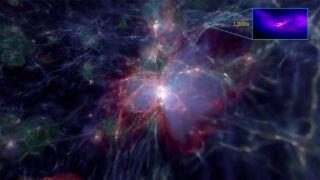In astronomy, there are a lot of investigations that are connected to the study of massive black hole sources in the universe. The present paper on astronomy offers an overview of an article entitled Birth of Massive Black Holes in the Early Universe, published on January 23, 2019, on the ScienceDaily website was chosen. This story is devoted to research conducted by scientists located in Georgia Institute of Technology-assisted by astronomers from Dublin City University, Michigan State University, the University of California at San Diego, the San Diego Supercomputer Center, and IBM, who put forward a new theory on birth of massive black holes.
Major Discovery
As has already been mentioned, this article offers a unique approach to the origin of massive black holes. According to the study, massive black holes evolve in some dense starless regions that expand very quickly (Wise et al., 2019). The study is novel in that it makes a radical change in the previous point of view that the formation of massive black holes could happen solely in regions attacked by the powerful radiation of the nearest galaxies.
Moreover, conclusions of the study, published on January 23, 2019, in the scientific journal Nature and sponsored by the National Science Foundation, the European Union, and NASA, brought to light that massive black holes can be found in the galaxies significantly more often than previously regarded (Georgia Institute of Technology, 2019). Figure 1 offers a visualization of a supermassive black hole. This particular article was chosen among hundreds of others because it is devoted to groundbreaking research in astronomy. Also, it was interesting to read about the contemporary approach to the origin of massive black holes and how it differs from previously conducted studies.

Overview of Previous Studies
Earlier theories on the birth of massive black holes suggested that the primary reason for their emergence was ultraviolet radiation coming from nearby galaxies. According to John Ragen from the University of Dublin, investigations conducted in the prior years suggested that massive black holes could appear only under circumstances when there was exposure to high levels of star-formation killing radiation (Wise et al., 2019).
However, Michael Norman insists that even though ultraviolet radiation is not excluded from the number of various factors, it should be no longer considered a dominant element (Georgia Institute of Technology, 2019). Astrophysicist Mar Mezcua from the University of Montreal states that black holes in dwarf galaxies are believed to be the relics of the early seed black holes (Mezcua, 2019). However, the author supports the idea that there are some other reasons for the birth of massive black holes. In short, contemporary studies, to some extent, debunk previous theories and try to find other factors, apart from ultraviolet radiation, which led to the birth of massive black holes.
Importance of the Findings
Even though the importance of findings may seem unclear, studies of the origins of black holes are of extreme importance. Black holes are the most massive objects in the universe that are so dense that they do not let the light escape.
If they were visible, black holes would look like the brightest stars that would be located in the centers of every galaxy. Understanding the reasons for the formation of these objects allows scientists to understand the structure of the universe. If scientists are able to figure out the origins of supermassive black holes, they will acquire a better understanding of how the universe was born, since these objects contain gravitational singularities. In short, black holes may contain the deepest secrets of the world, and the discussed article sheds light on them.
Perspectives of the Investigation
Since the research provides an entirely new approach and provokes the scientific community to rethink the whole matter, it can be flourishing in the long-term. The research team states that they would like to devote their future investigation to the issues related to the massive black holes’ lifecycle (Georgia Institute of Technology, 2019). They also would like to study the process of the first black holes’ formation, growth, and evolution over time (Georgia Institute of Technology, 2019). The future of the research seems promising, and if the scientists succeed in achieving their goals, they can make other significant contributions to the matter.
Reflection
After having read this article published on ScienceDaily, I learned about the appearance of massive black holes in the universe. Moreover, I found out that there has been groundbreaking research performed by a group of scientists which rethought the factors that led to the birth of black holes. Previously, it was commonly accepted that black holes were, so to say, born due to the ultraviolet radiation streaming from nearby galaxies.
Contemporary researches prove that ultraviolet radiation which used to be regarded as the main factor leading to the appearance of black holes is not the only reason for that phenomenon. Modern investigations offer the theory according to which black holes appear in the rapidly evolving starless regions. Also, it was found out that massive black holes appear much more commonly in the universe than previously regarded. This study impressed me very much, so now I would like to follow up on future research by this team and learn about the evolution of the black holes.
References
Georgia Institute of Technology. (2019). Birth of massive black holes in the early universe. ScienceDaily. Web.
Mezcua, M. (2019). Dwarf galaxies might not be the birth sites of supermassive black holes. Nature Astronomy, 3, 6-7. Web.
Wall, M. (2019). Supermassive black holes likely born in ‘halos’ of dark matter. Space. Web.
Wise, J. H., Regan, J. A., O’Shea, B. W., Norman, M. L., Downes, T. P., & Xu, H. (2019). Formation of massive black holes in rapidly growing pre-galactic gas clouds. Nature, 566(7742), 85-88. Web.